Introduction: Why is it important to choose the right crate? The Key to Safety and Comfort for Your Dog or Cat Traveling by Air
When traveling or moving with pets by air, it is an important responsibility of pet owners to provide a safe and comfortable environment for their pets. Especially in the cargo hold of an airplane, which can be an unfamiliar environment,Choosing the right transport crate (carrier, cage) is key to pet safety and stress reductionThey are holding the
Inappropriate crates not only increase the risk of injury, escape, and heat stroke during transportation, but can also result in denial of boarding by the airline. This guide will provide clear explanations of the essential points for choosing the best crate, assuming that the crate will be transported in the cargo compartment, primarily as checked baggage.
Do you have any concerns about choosing a crate or preparing for air travel?
PetAir's expert staff will provide you with the best advice for your situation.
It all starts with accurate measurements: Measure your pet's size!

The first step in selecting a crate is to know the exact size of your pet. Measure the following four dimensions with your pet standing naturally.
- A: Body length(tip of nose to base of tail)
- B: Height to elbow(ground to elbow joint of foreleg)
- C: Body width(widest part, such as shoulder width)
- D: Body height(from the ground to the top of the head *to the tips of the ears in the case of standing ears)
Measurement tips:
- Use a soft measuring tape and measure along your body.
- If the pet moves, it is easier to measure by two people or by using a wall.
- Measure several times and use the largest value.and you are less likely to make a mistake in size selection.
How to determine crate size: "formula" and "actual comfort"

Based on the pet's measurements, the crate'sinside dimensionsDecide on the
IATA standard formula (minimum standard)
The International Air Transport Association (IATA) provides a formula for calculating the minimum required inside dimensions. This has been adopted by many airlines as a global standard.
IATA Standard Calculation Formula (Inside Crate Dimensions)
- Minimum Internal Length = A (body length) + 1/2 B (elbow height)
- Minimum Internal Width = C (body width) x 2
- Min. internal Height = D (body height) + thickness of rug
Caution: this is only forMinimum Standardsare. Short-headed breeds (snub-nosed dogs and cats), in particular, are moreSize about 10% largeis recommended.
The most important "functional requirement."
The formulas are only a guide. Most important,The pet must be able to perform the following actions in the crate without difficultyIt is. This is an absolute requirement.
POINT: Behavior to be checked in the crate
- Standing: Can the head and ears stand naturally without touching the ceiling? (Approximate guideline: 7-8 cm of room above your head)
- Change of direction: Can you turn your body around without difficulty?
- Lie down: Can you stretch out and lie down in a comfortable position?
If in doubt, choose a slightly larger size and be sure to check the regulations of the airline you are flying with. Too small and you risk denial of boarding; too large and your body may sway and become unstable during transport.
"Which size fits my child?" I've done the math, but I'm not sure..."
Choosing the right crate size requires expertise, and PetAir can help you choose the best crate for your pet.
The key to safety! Structural checkpoints for crates
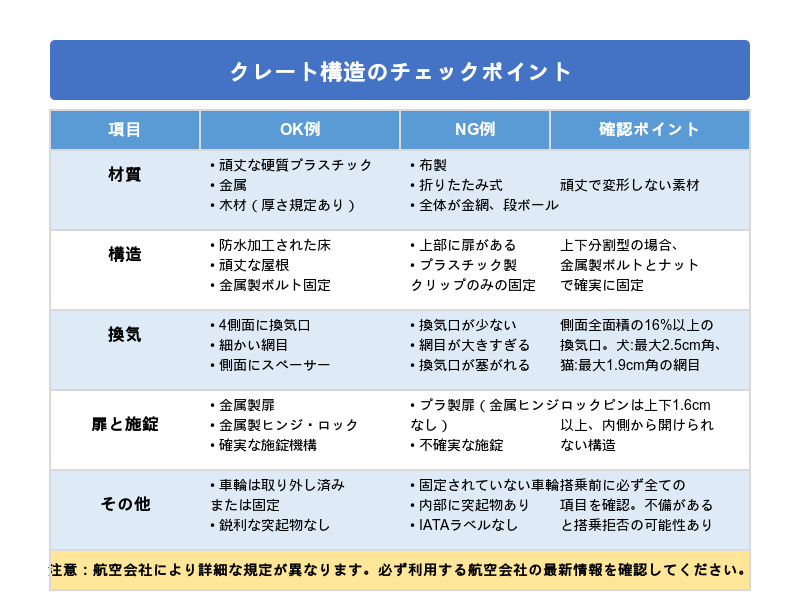
Once the size is determined, check that the construction of the crate itself meets safety standards. Airlines have detailed regulations for safe transportation.
material properties
- OK (recommended):: OK Rugged hard plastic
- OK (Conditional): The Metal, wood (must be the thickness specified by the airline)
- NG:. Made of cloth, rattan (tou), collapsible, entirely wire mesh or grid, cardboard, etc. (Insufficient strength, risk of breakage or escape)
structure
- The floor is sturdy.waterproof(to prevent leakage of excrement). (to prevent excrement from leaking).
- The roof is sturdy,No doors or ventilation openings at the topTo. (to prevent blockage or damage when objects are placed on top)
- For upper and lower split crates,Must be securely fastened top and bottom with metal bolts and nuts(Plastic clips and clasps only types are not acceptable. (Plastic clips and clasps only arenot allowed)
Important: Check bolt and nut fixation
The type of crate that is secured only by plastic clasps may come off due to shocks during transportation,Prohibited by many airlinesAt the time of purchase and before use, always check to see if the crate is the type that is secured with metal bolts and nuts. If you cannot find a crate that fits, or if you are in any doubt as to its suitability, please contact us.
ventilation
- As a rule, 4 sides(including doors) must have sufficient ventilation openings. (IATA specifies that at least 3 sides must be provided, and 4 sides are required depending on the installation location.)
- The mesh of the ventilation openings and doors are,Pet's nose and toes are not showing.Fine to the extent that it is fine. (Approximate size: maximum 2.5 cm square for dogs, maximum 1.9 cm square for cats)
- If the mesh is large, it should be reinforced from the inside with fine wire mesh.
- To prevent the ventilation openings from being blocked by other cargo, the sides of the cratespacer(protrusions and edges).
Doors and locks
- The door ismade of metalis most desirable. (In the case of plastic doors, the door hinges (hinges) and locking pins should be made of metal.)
- Locked securely,Structure that pets cannot open from the inside(e.g., spring-loaded locks are common). (e.g., spring-loaded locks are common)
- The lock pin (can opener) can be used in the upper and lower holes of the crate body.At least 1.6 cmThe product must be firmly plugged in.
Other
- If it has wheels (casters),Always remove or completely secure with tape, etc.(To prevent it from moving during transportation). (to prevent it from moving during transportation)
- Make sure there are no sharp protrusions or areas inside the crate that could cause injury to the pet.
Note: Failure to meet standards = denied boarding
Crates that do not meet these criteria are,Denied acceptance upon check-in at the airportPossibly. If you are unsure if your crate meets the criteria or need help selecting an appropriate crate, please feel free to contact PetAir.
Airline regulations are complex and subject to change.
Is this crate safe?" Please check with PetAir for the most up-to-date information.
Special considerations: Short-bodied and multiple pets
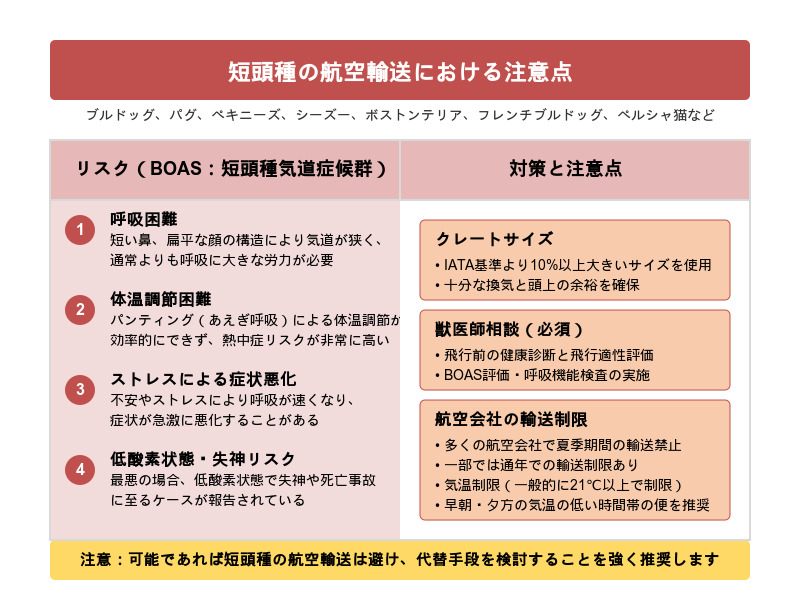
Special care should be taken when transporting certain breeds or multiple pets together.
Short-breed dogs (Bulldogs, Pugs, Pekinese, Shih Tzu, Pekinese, Boston Terriers, French Bulldogs, some cat breeds, etc.)
Significant risk: short-airway syndrome (BOAS)
Short-headed breeds have anatomical characteristics of a short nose and narrow airways (short-headed airway syndrome: BOAS). For this reason,Very high risk of heat and stress-induced breathing difficulties and heat stroke compared to other breeds of dogs and catsThe transportation of the product is a life-threatening situation.
Airline transportation restrictions:In many airlines,Suspend or limit acceptance of shortbreds during the summer months (e.g., around May-October) and possibly year-roundThe company is doing so.
Most importantly, be sure to check the latest regulations of the airline you plan to use (applicable breeds, restriction periods, conditions, etc.) and consult with a veterinarian to carefully determine suitability for flight in advance.
Crate measures for short-headed breeds:
- more than usual10% or larger (or one size larger)and use a well-ventilated crate. (IATA recommendation).
- Pay special attention to temperature control inside the crate. (e.g., cool mats)
Flying with short-bodied pets requires especially careful preparation.
At PetAir, our staff with extensive experience in transporting shorthorse breeds can provide specific advice and support to minimize risk.
Consult with us about shorthorse transportation (free of charge)
The following article explains more about short-horned breeds.
When transporting multiple pets in the same crate
- Principle "1 crate = 1 animal":. The stress of transportation and confined spaces can cause pets that normally get along well with each other.Risk of becoming aggressive or injuring each otherThere are Therefore, most airlines, including JAL and ANA,We require that one animal be placed in each crate.
- Exceptional cases (airline permission required):. IATA regulations allow identical crate transportation under certain conditions (e.g., up to two adults of the same species and size weighing 14 kg or less and normally living together, or up to three juveniles less than 6 months old, of the same stomach and weighing 14 kg or less), but thisYou must always get permission from the airline in advance, andand a larger crate with enough space for each pet to meet the above "functional requirements" (standing, turning, sleeping).
Recommendations:For safety reasons, whenever possibleTransport each animal in a separate crate.We strongly recommend that you do so.
Preparation inside the crate: added comfort and safety
Once you have decided on the crate itself, prepare the internal environment to enhance your pet's comfort and safety.
Bedding
- Required: Highly absorbent(pet sheets, absorbent mats, towels, etc.) at the bottom of the crate. This will prevent the body from getting wet if it defecates during transportation.
- Increased sense of security: Usually usedScented towels and blanketstogether, it is easier for the pet to feel secure.
- Caution: Avoid items that pose a risk of accidental ingestion, choking, or entanglement (e.g., padded cushions, easily torn toys, etc.). Also, be careful not to block ventilation openings with rugs.
drinking water
- Required: Crate.Water bottle or container that can be securely fastenedis required.
- Recommendation:
- Nozzle-type water bottle(Water is not easily spilled when water is supplied).Especially for ANA, nozzle-type waterer must be installed on both domestic and international flights.It is considered to be a
- For water supply containersFreeze the water.Put it in (you can drink only what is dissolved, so it is hard to spill).
- If water can be supplied from outside the crate, it will be easier for staff to supply water during transit.
- Advance preparation: If you use a nozzle-type water bottle,Always check that your pet is accustomed to using the system beforehand.Please do. If you cannot drink, you risk dehydration.
meal
- Usually no feeding during transport (to prevent aspiration).
- However, be prepared for emergencies and delays,Empty tablewareto be secured inside the crate is recommended by IATA.
- It is also recommended that a small amount of dry food be placed in a plastic bag and affixed to the outside of the crate (for emergencies).
temperature control
- Summer: Place a cool mat or a frozen plastic bottle wrapped in a towel near the crate (however, items that cannot be secured inside the crate may not be allowed by the airline).
- Winter: You can add a blanket, or put a disposable warmer for pets on the outside of the crate (where the pet is not in direct contact with it), though,Please pay close attention to safety (e.g., cold burns, accidental ingestion, etc.) and follow the instructions of the airline.
identification information
- Required Label: A "Live Animals" label and an arrow label indicating "This Way Up". These are usually provided and affixed by the airline at check-in.
- Recommendation:
- Pet's name, breed/cat breed, sex, age
- Name, address, and emergency contact(s) of owner(s)
- Destination information (address, contact information)
- Flight number and connection information
A piece of paper with this information on it.Place the crate in a waterproof bag (such as a Ziploc) and attach it securely to the outside of the crate.and help in case of an emergency.
- Collar: It is recommended that they wear a collar with a lost-and-found tag with contact information. However,Avoid anything that is too loose and could get caught in the grate of the crate or anything else that is too ornate and dangerous. Be sure to remove the leash (pull rope) due to the risk of choking.
Prohibited items
- Toys, gum, bones, or other items that can be swallowed accidentally or chokedNever include a
Prepare the pets themselves: crate training and health care
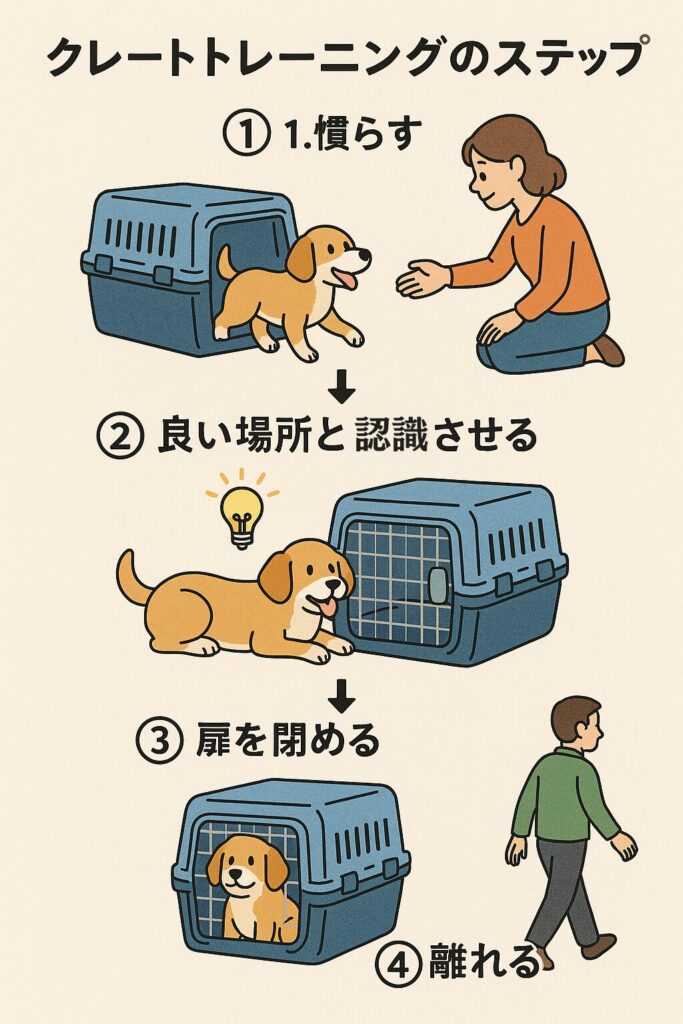
In addition to having an appropriate crate, it is also very important to prepare the pets themselves to withstand transportation by air.
Crate training (most important!)
It is not an exaggeration to say that the success or failure of air transportation can make the difference between success and failure,Pre-crate trainingIt is.
POINT: Goals of Crate Training
The goal is to have the pet crateIt's not a "place of punishment" or a "scary place to be locked away."Your own safe and serene den (den)"and to be aware of it.
Training Method:
- Beginning of acclimation (weeks to months ago): Beginning weeks or months before the trip, place the crate in the routine and allow free access to it. The door should be left open.
- Positive associations: Associate "crate = place of good things" by giving treats and putting favorite (safe) toys in the crate.
- Extend the length of stay: Once your pet is relaxed and in the crate, try closing the door for short periods of time. Start with a few seconds and gradually increase the time.
- Practice leaving the owner: With the door closed, the owner will try a short distance away. Again, start with a short period of time and gradually increase the distance and time.
Training Notes:
- Never use it as a punishment: Putting a dog in a crate as punishment for misbehavior, for example, creates a negative image.
- If he barks, he doesn't let it out right away: Do not open the door immediately after barking or making noise in the crate. This is to prevent your dog from learning that he will be let out if he makes a fuss. When he becomes quiet, praise him and let him out.
- No pressure: If your pet does not like it, do not force it, but return to the previous step and proceed slowly.
Are you worried that crate training is not progressing well?
PetAir's experts will advise you on training methods that suit your pet's personality and situation.
health care (e.g. for the aged)
- Consultation with a veterinarian: Always consult your veterinarian in advance to make sure you are fit for air transport with a medical examination.Please do. This is especially essential for older pets, pets with pre-existing conditions, pregnant pets, and the aforementioned short-headed breeds.
- Preparation of required documents:
- Health Certificate: Depending on the airline and destination country/region, a health certificate issued by a veterinarian may be required.Often has an expiration date (e.g., within 7 days of issuance)It is important to note that the
- Vaccination certificate: Proof of rabies and other vaccinations may be required.
- Microchip: Wearing and registration are often mandatory on international flights.
- Import permit and quarantine procedures: Follow the rules and regulations of the destination country/region and complete the necessary documents and procedures.Check early and start preparingPlease do so. The procedure often takes time.
Rabies vaccination and microchipping are explained in detail in the following articles.
▶︎Essential for pet travel abroad! A Thorough Guide to Microchipping Dogs and Cats
Do you feel that there are many necessary documents and procedures to go through?
PetAir can assist you with the complex paperwork and quarantine procedures for international shipments. Please feel free to contact us for more information.
About Sedatives
As a rule, sedatives are not used.Please use the following
Sedatives slow the body's natural response to changes in air pressure and environment, including respiratory depression and adverse effects on the cardiovascular system,Increased risk of serious unanticipated side effectsTherefore, many airlines and veterinary organizations do not recommend (or prohibit) their use.
Even if the veterinarian has indicated the use of sedatives for therapeutic reasons,You must always declare this to the airline in advance and obtain permission.Absolutely no unauthorized use is permitted.
Pre-departure care
- Meals: Departure.Up to 2-4 hours beforeIt is advisable to eat a light, easily digestible meal at least once a day. Transporting on a full stomach can cause motion sickness and vomiting.
- Hydration: Water can be given until just before departure.
- Walking and defecation: Before heading to the airport or before check-in,Adequate walking and eliminationLet's get the following done.
- Nail clippers: Clip the nails beforehand to prevent them from getting caught in the mesh of the crate.
7. final confirmation and airport formalities: for a smooth departure
Once you are ready, it is time to depart. Make final checks to ensure smooth procedures at the airport.
Final confirmation with airline (several days before departure)
Since regulations may change even after booking, check the following points with the airline again a few days before departure.
- Are you sure your pet's appointment is secure?
- Final pet acceptance requirements (crate rules, short breed restrictions, etc.)
- Final confirmation of required documents (e.g., expiration date of health certificates)
- Charges for transportation and payment methods
- Check-in counter location and closing time
- Is there any change in the aircraft (type of plane) on the day of the event (some aircraft may not be able to accommodate pets)?
- letter of intentis required, download, fill out and bring it in advance.
Arrive at the airport early
Important: Allow plenty of time!
Check-in for pets takes longer than normal boarding procedures. This is because documents are checked, the pet's condition is checked, and the crate is inspected,Allow more time than the airline's specified cutoff time (1.5 to 2 hours before departure for domestic flights and at least 3 hours before for international flights).Try to arrive at the airport. If you are late, you may not be allowed to board.
check-in
- At the designated counter, present your pet, crate, and required documents. A staff member will strictly check the pet's health, whether the crate meets regulations, and whether the documents are complete.
- If deficiencies are found here, in the worst case, you may be denied boarding.
- Pay the fee.
- Allow your pet one last potty break and hydration before putting him or her in the crate.
- Place the pet in the crate and make a final check that the door is securely locked.
- If the owner shows signs of anxiety, the pet will feel it. Remain calm and speak to your pet gently as you say goodbye.
Summary: Be well-prepared for a safe flight with your dog or cat!
Air travel with pets may cause a lot of worry for pet owners,Careful preparation is the key to success.It is.
Ensure that the following steps are taken
- Measure: Start by accurately measuring your pet's size.
- Select: The formula should be used as a minimum guideline. Choose a crate that is large enough for your pet to move comfortably inside and has a sturdy construction that meets airline safety standards.Bolt and nut fixation is especially important.
- Preparedness: The inside of the crate should be comfortable with an absorbent rug and a fixed waterer. And above all,Get pets accustomed to their crates (crate training).Make sure you are in good health and have all the necessary documents ready as soon as possible.
- Confirmation: Always check the latest information on the airline you are usingand be aware of short-horse restrictions, required documents, and procedures. Allow plenty of time to get to the airport.
By carefully following each of these steps, we can minimize the stress and risk to your pet during transportation and ensure safe and comfortable air travel.
It takes time and effort, but it is all for the sake of your pet, your precious family member. Please prepare well and create wonderful travel memories with your pets.
PetAir provides total support for air travel with pets, from preparation to arrival.
No matter how small the question or concern, please feel free to contact us first. Free online consultations are also available at any time.
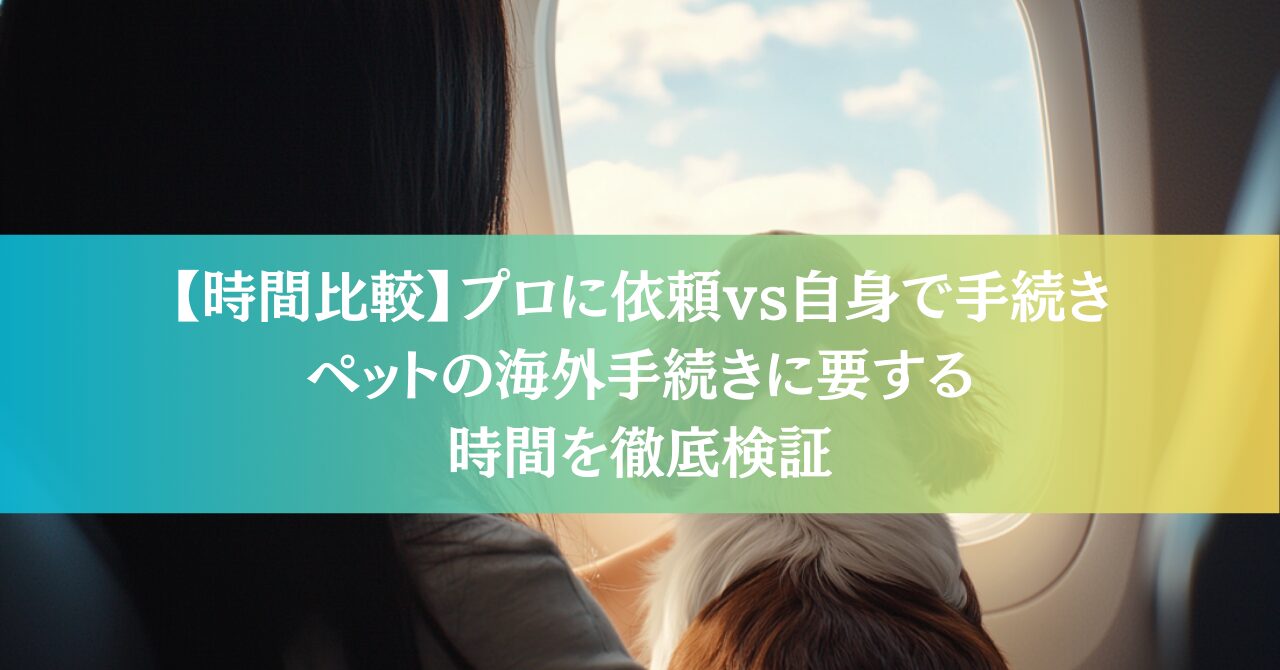
Detailed description of the actual time involved in the international shipping process for pets. The typical 90-125 hours of work can be reduced to just 8-11 hours with the use of experts. A thorough guide to the entire process and the nine time-saving benefits. Supports safe and efficient international travel for pets.
PetAir JPN: Safe overseas travel with pets.
Traveling abroad with your pet, a precious member of the family.
There are many things to prepare for, such as regulations, required documents, and transportation procedures in each country, which can be very anxious.
PetAir JPN will be there for such anxieties of pet owners and provide full support from travel planning to arrival.
PetAir Support Details
- according to the destination's regulations.Optimal PlanProposal for
- Necessary procedures andDocument preparation support
- Safe and comfortableTransportation Methods
- From Departure to ArrivalReliable support for
Reliable Support System
- By experienced staffCareful hearing and response
- CountriesLatest Regulatory InformationIdentification and prompt response to
- During transportationsafety managementThoroughness of
I want to start a new life with my beloved pet."
Let us help you give shape to that desire.
First, please contact us to discuss your needs at a free consultation.
Our experienced staff will propose the best plan for you and your pet.
\ First of all, free consultation on line! / /
Free consultation on line and online consultation appointment
Consultation is completely free of charge.
Free online consultation is also available.
Weekends and holidays are also available (JST 10:00-19:00)
References
(Note: The following is a list of related sources. The linked information is subject to change and links may be broken. Please check each official website for the most up-to-date information.)
- International Air Transport Association (IATA) - Live Animals Regulations (LAR) and related guidelines
- Japan Airlines (JAL) - For Passengers with Pets
- interpoint (interword separation)domestic airline (company)
- interpoint (interword separation)international air route
- All Nippon Airways (ANA) - Passengers with pets
- interpoint (interword separation)domestic airline (company)
- interpoint (interword separation)international air route
AVMA (American Veterinary Medical Association) ,
- International Pet Animal Transport Association (IPATA)
- Animal Quarantine Service (Ministry of Agriculture, Forestry and Fisheries) - Import and export of dogs and cats (Japanese quarantine information)
![Support for pets traveling and moving overseas|PetAir JPN [Official] for international transportation and quarantine procedures for dogs and cats Support for pets traveling and moving overseas|PetAir JPN [Official] for international transportation and quarantine procedures for dogs and cats](https://petair.jp/wp-content/uploads/2024/08/main_logo.png?1765162425)
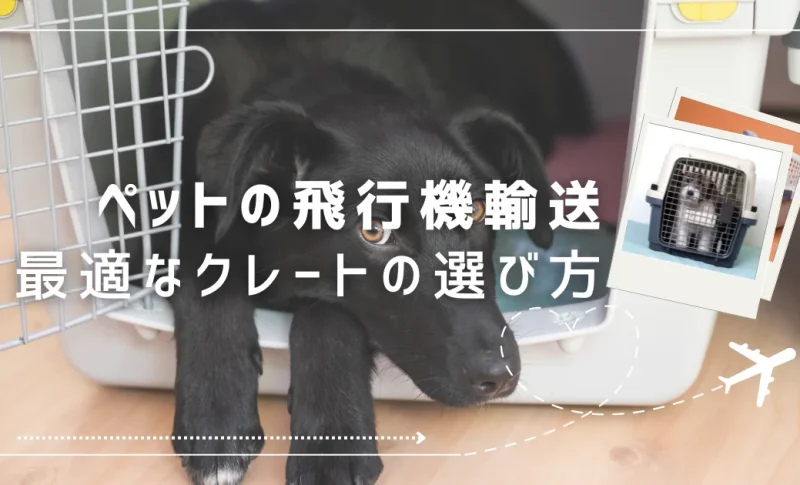


Comment